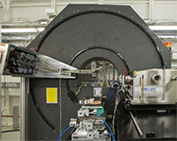Inelastic X-ray Scattering
Electronic & Chemical & Magnetic Characterization (X-ray/soft-X-ray spectroscopy)
Due to the upcoming SLS 2.0 upgrade this technique will be unavailable at PSI until further notice.
By using Inelastic X-ray Scattering (IXS) knowledge on dynamics in materials is obtained. This gives information that is often hard to achieve using static probes, such as the type of atomic bonding, valence state, and collective modes, resulting in a better understanding of the system at play.
In X-Ray Raman Scattering (XRS) soft x-ray atomic absorption edges are measured similar to X-Ray Absorption Spectroscopy (XAS) but with an important difference. In XRS hard x-rays (e.g. 10 keV) are used in a non-resonant fashion, giving bulk sensitive information devoured of unwanted surface contamination. The imaging capability of the XRS spectrometer gives spatially resolved chemical contrast which means complicated sample environments (e.g. in-situ battery cells) can be accommodated in the setup. Access beyond the dipole transition is also possible, providing information on the complete unoccupied density of states.
Resonant Inelastic X-Ray Scattering (RIXS) is a photon-in/photon-out technique that requires the X-rays to be tuned to an atomic absorption edge in order to observe a signal. RIXS is therefore element and valence specific technique. It measures excitations, such as dd- and magnetic-excitations, with a momentum resolution. This latter point is important since it allows one to map the energy dispersion of an excitation (e.g. magnon) which is crucial for any realistic theoretical modelling of a system. However, due to the large energy range in absorption edges, instruments are typically divided into soft, tender or hard x-rays.

Instruments datasheets


